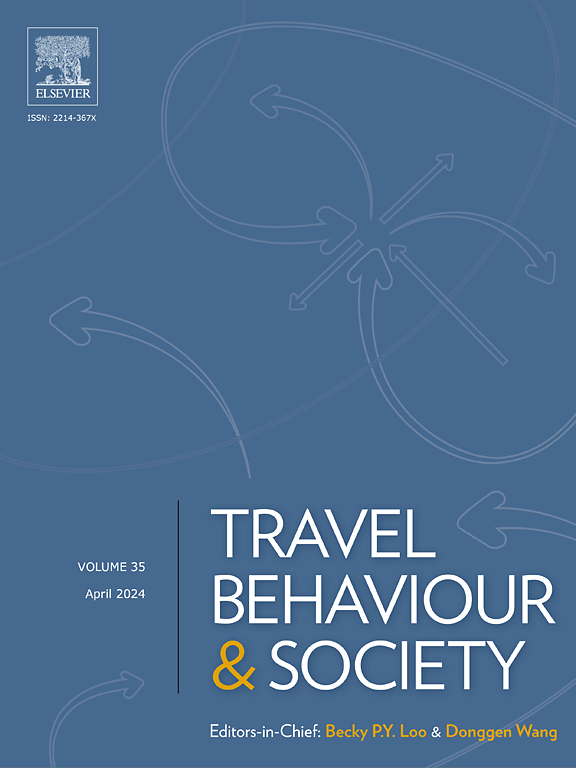利用实时GTFS生成出行时间不确定条件下易于使用的交通可达性测度
IF 5.1
2区 工程技术
Q1 TRANSPORTATION
引用次数: 0
摘要
以往关于出行时间不确定性下交通可达性测度的研究,往往引入基于非标准数据格式的复杂测度,阻碍了研究和规划的可重复性和可复制性。为了解决这个问题,我们提出了一个实用的框架,该框架利用了实时交通数据的标准化格式:实时通用交通馈送规范(GTFS),以在旅行时间不确定的情况下生成易于使用的交通可达性指标。该框架首先通过使用Realtime GTFS信息校正Scheduled GTFS数据产生两个数据集:Realtime P50 GTFS和Realtime P85 GTFS,用于计算两个可访问性度量:中间校正的可访问性(使用Realtime P50 GTFS)和离散校正的可访问性(使用Realtime P85 GTFS)。这些可达性措施在美国俄亥俄州哥伦布市进行了一项实证研究,研究了忽略旅行时间不确定性问题如何扭曲医疗可达性、不平等和新交通项目评估的分析结果。结果表明,忽略旅行时间不确定性的计划可达性(使用计划GTFS数据)高估了约10.97%的医疗可达性。此外,这种疏忽未能捕捉到新公交服务在改善可达性和减少不平等方面的好处。此外,尽管研究结果一致表明,与富裕社区相比,低收入社区在医疗保健可及性方面取得了更大的进步,但我们的分析揭示了在使用计划和分散校正的可及性措施时的统计显著差异。这些发现强调了将出行时间不确定性纳入公共交通规划和评估的重要性。我们的框架允许交通当局和研究人员使用标准化的数据格式准确地测量可达性,并在旅行时间不确定的情况下评估项目。本文章由计算机程序翻译,如有差异,请以英文原文为准。
Using Realtime GTFS to generate easy-to-use transit accessibility measures under travel time uncertainty
Previous studies on measuring transit accessibility under travel time uncertainty often introduced complex measures based on non-standard data formats, hindering reproducibility and replicability in research and planning. To address this, we present a practical framework that leverages a standardized format for real-time transit data: Realtime General Transit Feed Specification (GTFS), to generate easy-to-use transit accessibility measures under travel time uncertainty. This framework first produces two datasets by correcting Scheduled GTFS data using Realtime GTFS information: Realtime P50 GTFS and Realtime P85 GTFS, which are used to compute two accessibility measures: median-corrected accessibility (using Realtime P50 GTFS) and dispersion-corrected accessibility (using Realtime P85 GTFS). These accessibility measures are applied in Columbus, Ohio, USA for an empirical study examining how overlooking travel time uncertainty issues can distort the analysis results of healthcare accessibility, inequality, and new transit project evaluation. Results indicate that scheduled accessibility (using Scheduled GTFS data) which overlooks travel time uncertainty overestimates healthcare accessibility by approximately 10.97 %. Moreover, this oversight fails to capture the benefits of the new transit service in improving accessibility and reducing inequality. Furthermore, although findings consistently suggest that lower-income neighbourhoods experience greater gains in healthcare accessibility compared to wealthier counterparts, our analysis unveils statistically significant differences when using the scheduled and dispersion-corrected accessibility measures. These findings underscore the importance of incorporating travel time uncertainty into public transit planning and evaluation. Our framework allows transit authorities and researchers to accurately measure accessibility and evaluate projects under travel time uncertainty using a standardized data format.
求助全文
通过发布文献求助,成功后即可免费获取论文全文。
去求助
来源期刊

Travel Behaviour and Society
TRANSPORTATION-
CiteScore
9.80
自引率
7.70%
发文量
109
期刊介绍:
Travel Behaviour and Society is an interdisciplinary journal publishing high-quality original papers which report leading edge research in theories, methodologies and applications concerning transportation issues and challenges which involve the social and spatial dimensions. In particular, it provides a discussion forum for major research in travel behaviour, transportation infrastructure, transportation and environmental issues, mobility and social sustainability, transportation geographic information systems (TGIS), transportation and quality of life, transportation data collection and analysis, etc.
 求助内容:
求助内容: 应助结果提醒方式:
应助结果提醒方式:


